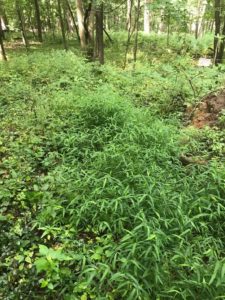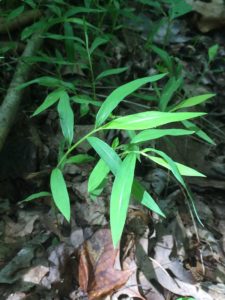Though Japanese stiltgrass has been threatening forests and wildflowers in the southeast and Midwest for years, it has only been found in Michigan for the first time this fall. One of these patches is here in southwest Michigan, near the city of Niles.
Japanese stiltgrass, which was accidentally introduced when used as packing material, can grow quickly and densely, degrading forests. “Stiltgrass can smother and outcompete native wildflowers, forbs, and grasses,” says Eleanor Serocki, Coordinator for the SWxSW Corner Cooperative Invasive Species Management Area, “it’s been a major problem in other areas, so we have to work quickly to ensure it doesn’t become one here.”
The trick to managing any invasive species is to locate it early, before it can become established, especially since the seeds of stiltgrass can remain in the soil for up to 10 years. Because of this, the CISMA and the DNR are hoping citizens will keep an eye out on trails and roads, and during yard clean-up this fall. Stiltgrass looks almost like delicate bamboo, growing low (1-3ft) to the ground, with tapering leaves which have a distinctive silver midrib. It grows especially well in disturbed areas, roadsides, and wet forests.
If you think you have seen Japanese Stiltgrass, or if you have any other questions, please contact Eleanor Serocki at the CISMA at 269-657-4030×5 or [email protected]. More information on Japanese stiltgrass are also available at michigan.gov/invasives or misin.msu.edu.
The Southwest X Southwest Corner Collaborative Invasive Species Management Area (CISMA) is a grant funded program to manage invasive species in Berrien, Cass, and Van Buren counties. With funding from the Michigan Invasive Species Grant Program, the CISMA aims to help landowners and stakeholders in the Southwest Michigan area manage invasive species. If you have any questions on Invasive species, please contact the CISMA at (269)-657-4030 or email photos and address or latitude/longitude to: [email protected].
Photos Via Michigan DNR


